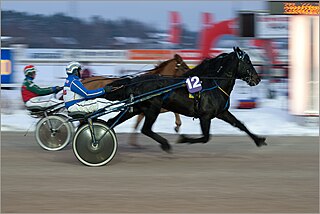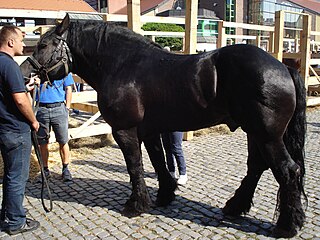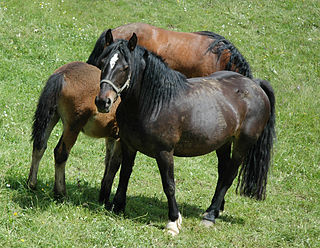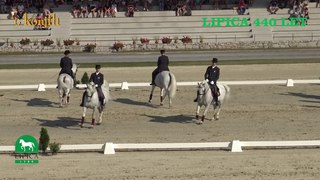The Priob or Ob is an endangered Russian breed of small horse from the Khanty-Mansi Autonomous Okrug, in Tyumen Oblast in the Russian Federation. It is distributed in the area of the Irtysh and lower Ob Rivers in western Siberia, and is a traditional breed of the indigenous people of that area, who used it for agriculture, for draft work, for forestry, and as a pack-horse.

The Zaniskari or Zanskari is a breed of small mountain horse or pony from Ladakh in northern India. It is named for the Zanskar valley or region in Kargil district. It is similar to the Spiti breed of Himachal Pradesh, but is better adapted to work at high altitude. Like the Spiti, it shows similarities to the Tibetan breeds living on the other side of the Himalayas in neighbouring Tibet. It is of medium size, and is often grey in colour. The breed is considered endangered, as there are only a few hundred alive today, and a conservation programme has been started at Padum, Zanskar, in the Kargil district of Ladakh.

The Pinzgauer is a breed of domestic cattle from the Pinzgau region of the federal state of Salzburg in Austria. It has distinctive colouring, with chestnut-brown sides and white back and underside. It was in the past a triple-purpose breed, raised for meat, milk and draught use. There is a naturally polled sub-type, the Jochberg Hummel. In 2007 the breed was not considered by the FAO to be at risk.

The Sokolski, Polish: Sokółski or Koń sokółski, is a Polish breed of draught horse. It is named for the town and county of Sokółka, near Białystok in north-eastern Poland, where it was first bred in the 1920s. It derives from cross-breeding of local Polish mares of Polish Coldblood type with imported Trait Belge and Ardennais stock. It is distributed mainly in the voivodeships of Lublin and Podlasie. It is clean-legged; the usual coat colour is chestnut.

The Rhenish German Coldblood, German: Rheinisch Deutsches Kaltblut, is a breed of heavy draught horse from the Rhineland area of western Germany. It was bred in second part of the nineteenth century, principally at the Prussian state stud at Schloss Wickrath in Wickrathberg, now part of Mönchengladbach in North Rhine-Westphalia.

The North Swedish Horse or Swedish: Nordsvensk Brukshäst is a Swedish breed of small heavy horse. It is closely related to the similar Dølehest breed of Norway. It was traditionally used for forestry and agricultural work. Lighter lines are bred for harness racing, and are registered in the stud-book of the Svensk Kallblodstravare.

The Misaki is a critically-endangered Japanese breed of small horse. It is one of eight Japanese native horse breeds, and lives as a feral horse in a natural setting in a designated National Monument on Cape Toi within the municipal boundaries of Kushima at the south end of Miyazaki Prefecture on the island of Kyūshū. The Misaki was made a Japanese National Natural Treasure in 1953.

The Scandinavian Coldblood Trotter consists of two closely related and interconnected breeds of trotting horse: the Norsk Kaldblodstraver or Norwegian Coldblood Trotter and the Svensk Kallblodstravare, the Swedish Coldblood Trotter or North Swedish Trotter. Coldblood trotters are the result of cross-breeding native coldblooded farm horses – in Norway the Dølehest, in Sweden the North Swedish Horse – with lighter and faster horses. Although the Norwegian and Swedish coldblood trotters are substantially considered a single breed, two national stud-books are maintained, and registration requirements differ in some respects between the two countries.

The Schleswig Coldblood is a breed of medium-sized draught horse originally from the historic Schleswig region of the Jutland Peninsula, which today is divided between modern Denmark and Germany, and from which its name derives. It is found primarily in the northern German state of Schleswig-Holstein, and also, in smaller numbers, in Lower Saxony. It shares the origins, ancestry and much of the history of the Danish Jutland breed, and shows some similarity to the British Suffolk Punch. It is used in agriculture and forestry, and to draw coaches and wagons.
The Istriana or Carsolina, Croatian: 'Istarska Ovca', Slovene: 'Istrska Pramenka', is a breed of domestic sheep from Istria and the Karst regions of the northern Adriatic, from north-east Italy to Croatia and Slovenia.

The Međimurje horse is an autochthonous medium-heavy horse breed of draught horse originating from Međimurje County in northernmost part of Croatia.

The Croatian Coldblood is an autochthonous medium-heavy horse breed of draught horse originating from Croatia.

The Kiso or Kiso Horse is one of the eight indigenous horse breeds of Japan. It is the only native horse breed from Honshu, the principal island of Japan. Like most other Japanese native breeds, it is critically endangered.

The South German Coldblood is a breed of draught horse from southern Germany. It is distributed mainly in Bavaria. It is the most numerous of the four principal German draught horse breeds – the others being the Black Forest Horse, the Rhenish German Coldblood and the Schleswig Coldblood – and is the only one not listed as endangered by the FAO or by the Gesellschaft zur Erhaltung alter und gefährdeter Haustierrassen, the German national association for the conservation of historic and endangered domestic animal breeds.

Slovenian Cold-blood is an autochthonous breed of horse, originating in Slovenia. There are only four autochthonous horse breeds in Slovenia, besides Slovenian Cold-blood the Bosnian Mountain Horse, Lipizzan and Posavac also have this status. The breed got its current name in year 1964. Slovenian cold-blood horses are mostly bay or black, can have white facial markings and reach medium sizes.

Krškopolje pig or Black-belted pig is an autochthonous breed of pig, originating in Slovenia. This pig represents the only still preserved Slovenian autochthonous breed of domestic pig. The easily recognizable blackish Krškopolje pig, widely used for meat production, is well known for its continuous pink belt, running across animal's shoulders and forelimbs.

Horses in Slovenia are represented above all by the traditional Lipizzan breed, inherited from Austria-Hungary; like Austria, Slovenia claims the Lipizzan as its national symbol. Horses have long been present on Slovenian territory; draft horses suffered a sharp decline in the 20th century, with only the native breeds of Slovenian Cold-blood and Posavina surviving. Slovenian breeders also have sport horses, such as the Slovenian Saddlebred and the Ljutomer Trotter. Slovenians distinguish their native horse breeds from traditional breeds.
The Polish Coldblood is a modern Polish breed of draught horse of medium to heavy weight. It was formed in 1964 when the various regional draught breeds or types were merged into a single stud-book. Those local types derived from cross-breeding of local mares with imported stallions of heavy draught breeds, principally of Ardennais, Belgian Draught and Swedish Ardennes stock.

















